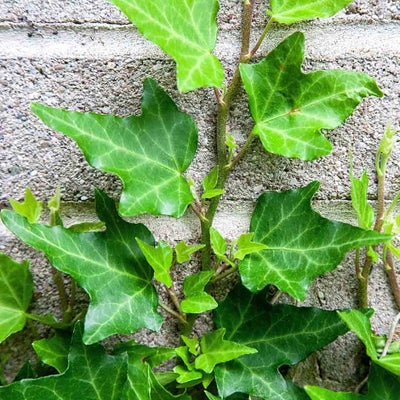
Quick facts
Ivy’s botanical name is Hedera helix; it is also known as common ivy or English ivy and is native to the UK
It is a fantastic plant for wildlife and helps to keep buildings cool in summer and warmer and less humid in winter
Ivy is a self-clinging climber, producing aerial roots along its stems
In most cases, ivy doesn’t damage buildings and fences, but it may need controlling or removing in some situations
If you need to remove ivy, non-chemical methods are effective
What does ivy look like?
Ivy is a vigorous, evergreen climber that can grow to 30m (98ft). Its purple-green stems become woody with age and produce (aerial) roots, allowing it to attach to walls, masonry and fences along with natural surfaces such as tree trunks.
It has two forms of growth – a juvenile climbing stage and a mature, bushy, non-climbing stage. The former has glossy, dark green leaves with 3-5 lobes and pale veins; the latter has heart-shaped leaves and bears clusters of yellow-green flowers in rounded heads from September to November. These are followed by black berries which each contain five seeds. Ivy tends to stay in its juvenile stage on house walls and fences, especially if it is regularly pruned, but a mature plant may begin flowering if it reaches the top.

Did you know?
The 12 species of Hedera, and their many cultivars, have long been studied by botanists. From The Ivy by James Shirley Hibberd in 1893 to Hedera Sorten by Ingobert Heieck in 1980 and the RHS’ Hedera: The complete guide in 2017, there is a wealth of information available to those wanting to learn more about these interesting, diverse and valuable climbers.
Is ivy a weed?
In many situations ivy is a useful plant. It has long been valued for adding year-round interest to house walls and is a quintessential part of the charm and elegance of many English country houses. Its ability to tolerate deep shade makes it especially useful in a garden, and there are a wide variety of yellow and white- cultivars that can brighten even the shadiest of walls and fences.
Ivy doesn’t just look attractive, studies have found that it cools buildings internally and externally by more than 5°C in summer compared to ‘bare’ buildings. Air trapped in the leaves and stems then acts as building insulation for the winter months. The foliage also acts like an umbrella to shed rain, reducing the inside buildings during the winter. What’s more, its dense evergreen foliage helps to trap airborne pollutants and attenuate noise.
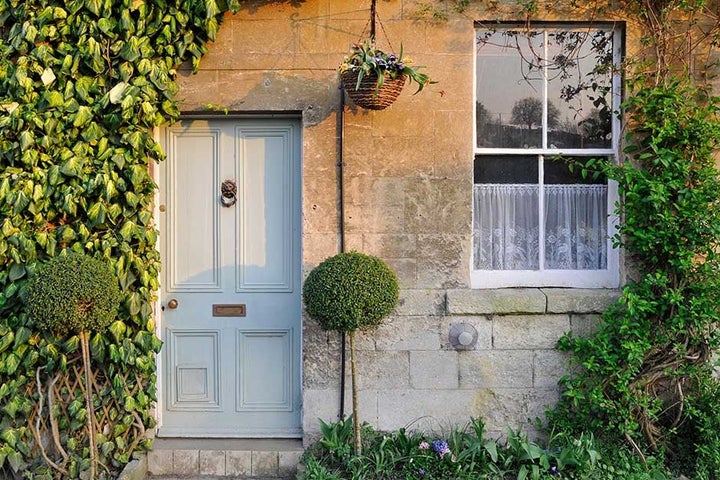

Ivy also has enormous value to wildlife:
- Its leaves provide year-round hiding, roosting and hibernating places for various insects, birds and small mammals
- It is a preferred nesting plant for dunnocks, flycatchers, wrens and robins
- Its leaves are an important food source for caterpillars of many butterflies and moths, including the holly blue butterfly and swallow-tailed moth
- If allowed to flower, it offers an invaluable late pollen and nectar source to many pollinating insects, including bees, hoverflies, wasps, butterflies and moths, and its high-fat berries are eaten by numerous different garden birds.

However, ivy is a fast-growing, vigorous plant and is often seen as a weed owing to its tendency to stray out-of-bounds. On buildings, it can grow into gutters, windows and roofs and make routine maintenance work difficult. Its dense growth may provide access for intruders, and potentially harbour household pests such as mice. In some specific cases, ivy may damage buildings (see below).
What is a weed?
The term ‘weed’ describes a plant that is growing where it isn’t wanted. Weeds usually thrive in average garden conditions, reproducing and spreading easily. It is up to you to decide what you call a weed and what you choose to retain or remove.
Frequently asked questions about controlling ivy on buildings and fences
Here are our answers to your most common questions about controlling ivy on buildings and fences:
How invasive is ivy?
Ivy spreads primarily by its fast-growing stems that root along their length. A single ivy plant can easily cover several standard fence panels in a decade or grow to the height of a two-storey house if allowed to do so in 15-20 years. Its self-clinging stems, capable of growing vertically and along the ground, and its dense, evergreen foliage, can quickly smother and outcompete other climbers and wall shrubs. Ivy can damage wooden fences if stems grow into gaps between slats or panels; when the stems thicken with age, they might push sections of fence apart.
The good news is that it is easy to keep ivy from straying out-of-bounds by annual pruning, and it will grow just as happily contained to a single fence panel or small portion of wall.
Ivy can also spread by seed, and as the berries are eaten by birds, they may be deposited a long way from the parent plant. generally don’t appear in large numbers and can be easily removed before they become established.
Does ivy damage buildings?
Ivy is regularly reported to damage the walls it grows on, and while there are some instances where it can cause or exacerbate damage, in most cases ivy does not cause these structural issues. Its aerial roots are unable to bore into sound masonry, and they often only cause damage when they are removed with force.
Studies have found that a covering of ivy can even benefit buildings. It lessens the effect of frost on vulnerable wall coverings, like plaster and lime mortar, and traps airborne pollutants which can blacken and erode them. It also acts as a shield against heavy rain-driven winds, which can themselves cause erosion and contribute to damp. And, while ivy is often believed to make buildings damp, there is evidence to the contrary – a covering of ivy has been found to lower inside buildings over winter. For more information see our research here and Historic England's web page here.
However, it is worth considering the following if you plan to buy an ivy-covered house or wish to plant an ivy to grow up a house wall:
- Ivy’s aerial roots can penetrate existing cracks and joints, enlarging them as the roots grow and expand
- A covering of ivy on a house that already has a damp problem can make it worse, by limiting how much the walls can ‘breathe’
- Its creeping stems can lift roof copings and slates, and grow into gutters, chimneys and roof spaces if not regularly managed
- A dense covering of ivy can hide damp problems and other defects in the fabric of the building, allowing them to get worse unnoticed
- If allowed to mature and become branching, ivy can add considerable weight to a structure, potentially destabilising masonry in windy conditions
- A mature ivy growing close to the base of a house wall could potentially cause subsidence issues if the house is old, has shallow foundations and is built on clay soil
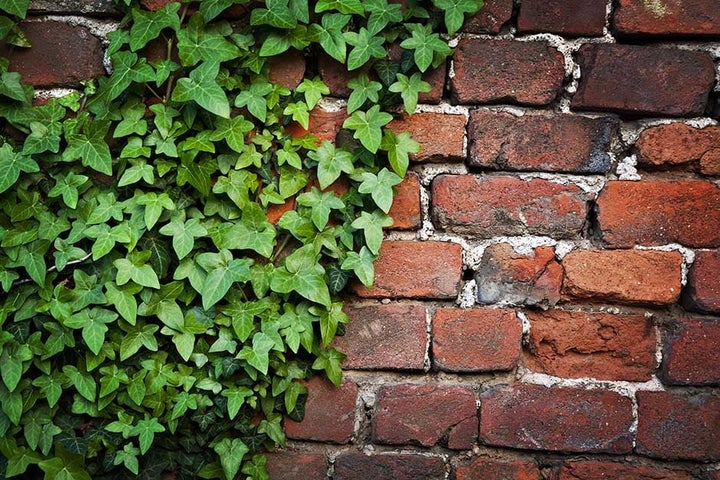

Do I need to get rid of ivy?
No – ivy is a fantastic plant for wildlife and an attractive and useful garden plant, providing colourful evergreen screening even in deep shade and offering a range of ecosystem services. In most cases, ivy doesn’t cause any damage to the buildings and fences it grows on, and it can be maintained at a modest and manageable size to boost the of your garden.
It is, however, a good idea to control the spread of ivy so it doesn’t stray out-of-bounds and cause a problem.
What is the easiest way to kill ivy?
Before deciding to remove ivy, particularly a large plant growing up a house wall, it is worthwhile doing a thorough inspection. The process of removing ivy can itself cause damage, pulling away paint and loose mortar, and you may need to carry out costly repair work, such as filling cracks and joints, re-rendering or repainting walls, after removal. Try carefully removing a small section as a test area, to see what condition the walls are left in, before deciding whether to proceed.
Top Tip
If you are concerned about a mature ivy on your house, or have spotted some damage and want it investigating, seek advice from a qualified building surveyor.
If ivy isn’t causing any damage, it is often best to leave it in place. However, if you have ivy growing where it isn’t wanted, or it is necessary to remove it, there are the following options:
- Cut back stems regularly – use secateurs or loppers to trim ivy growth away from gutters, windows, chimneys, roofs and any decorative or vulnerable wall finishes. Depending on the size and vigour of your plant, this may need doing a few times per year, but once a year is often enough. If you have a mature ivy, take care to remove branching growth from chimney stacks or old or damaged walls, as its extra weight can dislodge masonry.
- Partially remove ivy – this is a good option where ivy covers a large area and complete removal would be too difficult, or you wish to retain some coverage. Start with the outermost stems, which will be most strongly attached to the wall or fence, and use secateurs or loppers to cut and peel stems away. Work slowly and carefully to minimise dislodging loose masonry. Once you have brought the ivy back within bounds, begin regular trimming (above) or apply a deterrent to prevent regrowth (below).
- Prevent ivy attaching – RHS-funded research found that applying two coats of clear ‘easy-on’ anti-graffiti paint or fixing copper or zinc sheets, or copper mesh, to walls and fences, completely prevents ivy attachment without affecting plant health. Stems that grow onto these surfaces peel off naturally and just need trimming off at the boundary. This allows you to keep ivy within a desired area and limits maintenance.
- Remove all ivy stems – where you wish to remove ivy entirely, begin by cutting and carefully peeling off the outermost stems as above; an old palette or blunt table knife can be a helpful tool for getting under and peeling off stems. Work steadily inwards towards the larger, central stems. These will be less strongly stuck to the wall or fence, but will be thicker, woodier and less manoeuvrable, so you may need to use a saw to remove them in pieces. Although tempting, avoid pulling large sections off in one go, as you are much more likely to damage the structure beneath. It is also best to leave the main stems attached to their roots in the ground until the very end of the process, as severing them early on increases the chance of the plant ‘rooting-in’ to the wall further up.
- Dig out the stump – once you have removed all the ivy stems, use a sharp spade (and pickaxe if necessary) to remove the stump and as many large roots as possible. This will stop the ivy regrowing but is often not practical due to the stump’s proximity to the wall or fence base. If you can’t remove the stump, regularly cut any new growth back to ground level. This will weaken the plant, although it may take a long time to kill it.
- Remove unsightly root ends – when ivy stems are removed, they leave behind root hairs that are very strongly attached. These look unsightly and can persist for a long time. To remove them from walls or fences, use a wire brush, metal wallpaper scraper or pressure washer, being careful not to further dislodge any loose paint or mortar.
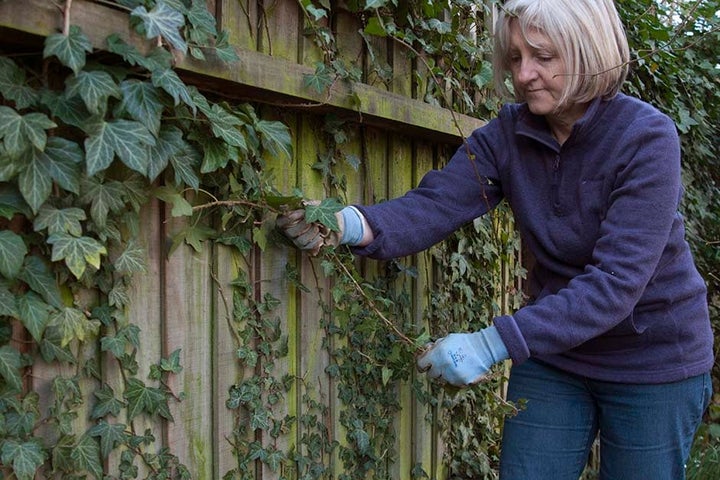
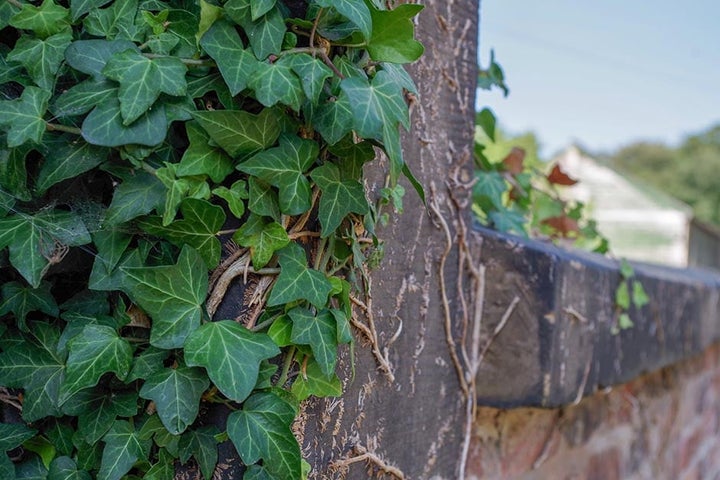
Top Tip
Check for nesting birds before you do any work to control or remove ivy. It is an offence under the Wildlife & Countryside Act 1981 to damage or destroy the nest of any wild bird while it is in use or being built. Nesting season generally lasts from March to August, but it may last longer for certain birds or those with multiple broods, so always check before starting.
Take care
Contact with ivy can irritate your skin, so wear gloves and cover arms/legs when handling it.
Should I use weedkiller?
No – although it takes time and patience to completely remove ivy, non-chemical methods are effective, so there is no need to use a weedkiller.
As ivy has glossy, moisture-resistant leaves, weedkiller sprays are often ineffective, and it may take several applications to see any marked effect. Attempting to kill off a large ivy with weedkiller is likely to be unsuccessful, and you would still need to carefully remove its stems and persistent root hairs after it dies.














